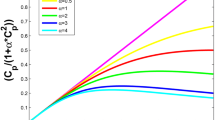Abstract
While the effects of unemployment on property crime has been recognized for decades, finding a comprehensive and effective strategy for its control remains a global challenge. A mathematical model of property crime “epidemic” that incorporates the effects of unemployment, in a rather simple setting, is proposed and analysed. The model subdivides the economically active population based on employment and property crime status. The transmission process from being a non-criminal to a criminal is modelled as a socially contagious process. The impacts of unemployment on property crime statistics is investigated through the threshold parameter known as the “basic ” reproductive number. In this paper the reproductive number accounts for the average number of cases generated by a “typical” criminal during his or her life time in a population of unemployed and employed economically active population. After comprehensive analysis of the model it is extended to incorporate multiple optimal intervention strategies aimed at reducing unemployment and property crime. Results here provide a frame work for designing effective time dependent methods aimed at reducing unemployment and property crime statistics.






Similar content being viewed by others
References
Adebayo AA (2013) Youths’ unemployment and crime in Nigeria: a nexus and implications for national development. IJSA 5:350–357
Nielsen L (2011) Classification of countries based on their level of development: how it is done and how it could be done. IMF working paper 11/31. Washington, DC, IMF
Kapuscinski AC, Braithwatie J, Chapman B (1998) Unemployment and crime: toward resolving the paradox. JOQC 14:215–243
Global employment trends for youth (2013) A generate at risk. International Labor Office, Geneva
Msigwa R, Kipesha FE (2013) Determinants of youth unemployment in developing countries: evidences from Tanzania. JEDS 4:67–76
Sooknanna J, Fima BB, Comissiong MGD (2013) Another way of thinking: a review of mathematical models of crime. Math Today 131–133
Sooknanan J, Bhatt B, Comissiong DMG (2013) Catching a gang-a mathematical model of the spread of gangs in a population treated as an infectious disease. IJPAM 83:25–43
Vargo L (1996) A note on crime control. Bull Math Biol 83:375–378
Nuno JC, Herrero MA, Primicerio M (2011) A mathematical model of crime-prone society. Discret Contin Dyn S 4:193–207
Castillo-Chavez C, Feng Z, Huang W (2002) On the computation of \({\cal R}_0\) and its role on global stability. In: Castillo- Chavez C et al (eds) Mathematical approaches for emerging and reemerging infectious diseases: an introduction, IMA, vol 125, pp 229–250
Li M, Muldowney JS (1996) A geometric approach to the global-stability problems. SIAM J Math Anal 27:1070–1083
Coppel WA (1965) Stability and asymptotic behavior of differential equations. Health, Boston
Fiedler M (1974) Additive compound matrices and inequality for eigenvalues of stochastic matrices. Czechoslov Math J 99:392–402
Fleming WH, Rishel RW (1975) Deterministic and stochastic optimal control. Spinger, New York
Lukes DL (1982) Differential equations: classical to controlled, mathematics in science and engineering. Academic Press, New York
Pontryagin LS, Boltyanskii VG, Gamkrelidze RV, Mishchenko EF (1962) The mathematical theory of optimal processes. Wiley, New Jersey
Lenhart S, Workman JT (2007) Optimal control applied to biological models. Chapman & Hall, London
National Bureau of Statistics (NBS) Report for Nigeria (2012)
Author information
Authors and Affiliations
Corresponding author
Rights and permissions
About this article
Cite this article
Mushayabasa, S. Modeling optimal intervention strategies for property crime. Int. J. Dynam. Control 5, 832–841 (2017). https://doi.org/10.1007/s40435-015-0201-2
Received:
Revised:
Accepted:
Published:
Issue Date:
DOI: https://doi.org/10.1007/s40435-015-0201-2




